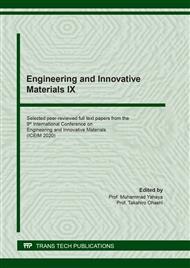[1]
Giuseppe E. Marcantoni: FROM MOLTEN METAL TO 3.2 mm WIRE FOR MECHANICAL APPLICATIONS, Light Metals 2012 Edited by Carlos E. Suarez, TMS (2012).
DOI: 10.1002/9781118359259.ch44
Google Scholar
[2]
Y. Otsuka, T. Nishikawa, Y. Yoshimoto, Y. Akasofu: Development of Aluminum Wire for Low-Voltage Automotive Wiring Harnesses, SAE Int. J. Passeng. Cars - Electron. Electr. Syst. Vol. 5 (2012), pp.486-491.
DOI: 10.4271/2012-01-0925
Google Scholar
[3]
M. G. Kim: Continuous Casting and Rolling for Aluminum Alloy Wire and Rod, Materials Science Forum, Vol. 638-642 (2010), pp.255-260.
DOI: 10.4028/www.scientific.net/msf.638-642.255
Google Scholar
[4]
M. Jabłoński: Effect of Iron Addition to Aluminium on the Structure and Properties of Wires Used for Electrical Purposes, Materials Science Forum, Vol. 690 (2011), pp.459-462.
DOI: 10.4028/www.scientific.net/msf.690.459
Google Scholar
[5]
K. Buxmann, E. Gold: Solidification Conditions and Microstructure in Continuously Cast Aluminum, JOURNAL OF METALS Vol. 34 (1982), p.28–34.
DOI: 10.1007/bf03337996
Google Scholar
[6]
N. Cheung, N. Santos, J. Quaresma, G. Dulikravich, A. Garcia: Interfacial heat transfer coefficients and solidification of an aluminum alloy in a rotary continuous caster, Int. J. Heat & Mass Transfer Vol. 52 (2009), pp.451-459.
DOI: 10.1016/j.ijheatmasstransfer.2008.07.003
Google Scholar
[7]
D. Lewis: THE PRODUCTION OF NON-FERROUS METAL SLAB AND BAR BY CONTINUOUS-CASTING AND ROLLING METHODS, Metallurgical Reviews Vol. 6 (1961), pp.143-192.
DOI: 10.1179/mtlr.1961.6.1.143
Google Scholar
[8]
J. Birat: Continuous casting for tomorrow: Near-Net Shape Casting, Rev. Met. Paris Vol. 86 (1989), pp.317-334.
DOI: 10.1051/metal/198986040317
Google Scholar
[9]
T. Haga, T. Miyake: Casting of Aluminum Alloy Rod by a Single Wheel with V-Groove, Key Engineering Materials Vol. 792 (2018), pp.53-58.
DOI: 10.4028/www.scientific.net/kem.792.53
Google Scholar
[10]
T. Haga, T. Miyake: Fabrication of Aluminum Alloy Rods Using a Single Wheel Caster with Rotating Side Dam Plates and Pool-Less Pouring, Key Engineering Materials Vol. 792 (2018), pp.46-51.
DOI: 10.4028/www.scientific.net/kem.792.35
Google Scholar
[11]
T. Haga , K. Tuchitani, H. Warari, S. Nishida: Casting of Bar Using a Twin Wheel Caster, Key Engineering Materials Vol. 831 (2018), pp.35-40.
DOI: 10.4028/www.scientific.net/kem.831.46
Google Scholar


